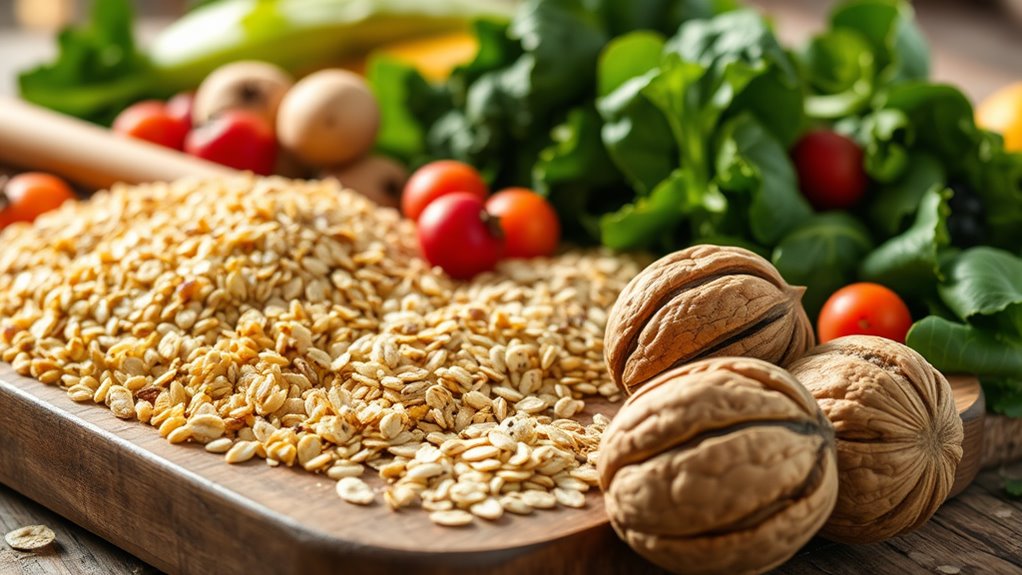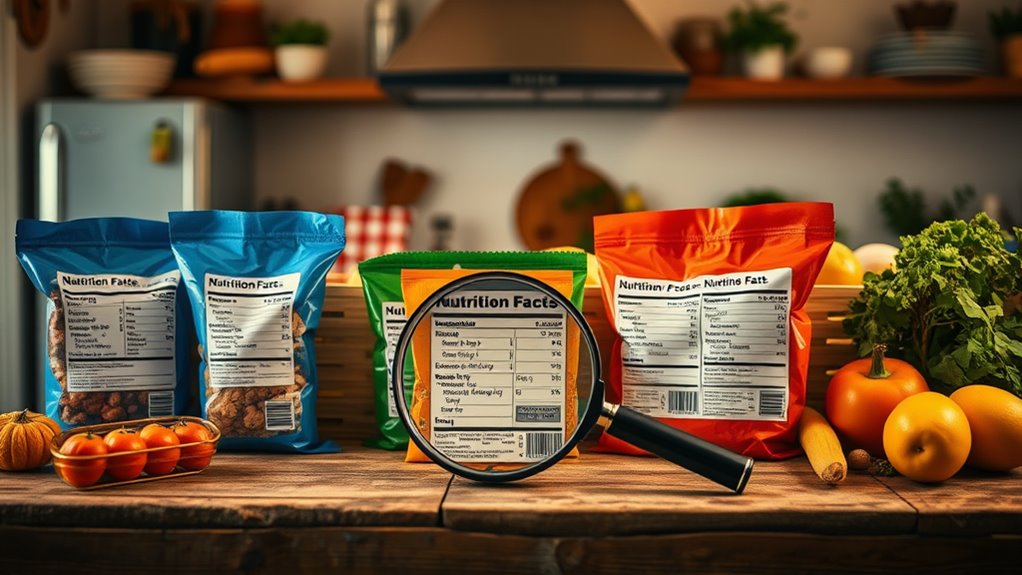
Decoding nutrition labels is vital for healthier eating. Start by understanding serving sizes to avoid overconsumption and accurately calculate total nutrients. Keep an eye on calorie content, and make sure you’re consuming healthy fats while limiting saturated fats. Monitor sodium levels and identify added sugars to keep them under 10% of your daily calories. Select foods high in fiber and essential vitamins, and use percent Daily Value to gauge nutrient intake. Remember, ingredient lists reveal the quality of your food—opt for whole ingredients. Emphasizing moderation and mindful eating can transform your diet into a healthier one—there’s more to discover.
Understanding Serving Sizes
Interpreting nutrition labels requires an understanding of serving sizes, a concept that plays an essential role in understanding food information. You deserve the power to make informed choices about what you eat, and serving sizes are your guide.
They’re not instructions on how much to consume but reflect typical consumption, helping you employ portion control for liberation over your dietary habits. By recognizing serving accuracy, you’re in control—armed with the knowledge to manage your intake responsibly. It’s crucial to note that serving sizes are mandated by law to reflect typical consumption amounts, ensuring consistency across food labels. When choosing products, it’s important to consider nutrient content claims, which ensure accurate representation of the product’s nutritional value.
Serving sizes appear in everyday measures like cups or tablespoons, translating everyday consumption into understandable terms. When you see “1/2 cup of pasta” or “2 tablespoons of peanut butter,” it’s not about restriction. It’s about clarity, liberating you from misinformation.
Understanding how servings translate to portions empowers you to align your dietary decisions with your personal health goals. Remember, a single portion may consist of multiple servings; a large soda, for instance, might hide multiple servings behind its label.
As you navigate labels, remember this isn’t about following norms; it’s about creating liberation through informed, conscious consumption. Use serving sizes to guide your dietary choices, making healthier living an attainable reality.
Calculating Total Nutrients
Now that you’re equipped with an understanding of serving sizes, let’s examine how to calculate the total nutrients in foods. By mastering this, you’ll release your power to make informed and liberating food choices.
Start by using the USDA National Nutrient Database to gather raw ingredient data. Convert amounts to grams if needed, then look up nutrient values per 100g or suitable serving size. Sum up the contributions of each ingredient to determine the total nutrient content. Keep in mind that accurate labeling is legally mandated to prevent misleading consumers. Considering the glycemic index of foods can aid in selecting healthier options depending on how they impact blood sugar levels.
Be mindful of nutrient density and processing factors, especially when dealing with composite foods. Break these down into subrecipes, and adjust for cooking losses. For instance, account for baking moisture loss as a percentage.
Use purpose-built software like Foodworks for complex calculations, guaranteeing an accurate nutrient profile. Pay close attention to core nutrients, such as sodium and saturated fats, as limiting these can enhance your food freedom.
If a product makes a specific nutrient claim, verify it’s included, like omega-3s. Validate your findings using calculation tools or seek laboratory analysis for precise details.
Always reflect the final product’s nutrient profile as consumed, considering processing factors. This approach empowers you to craft smarter dietary choices.
Evaluating Calorie Content

When it comes to evaluating calorie content, understanding the information on nutrition labels is key. Grasping the concept of calorie sources starts with examining the serving size. This isn’t a green light to consume it all at once—it’s simply what people typically eat in one sitting. Remember, monitoring calorie intake supports weight loss and reduces cancer risk. The number of servings per container is vital; it reveals if you’re consuming more than intended. Multiply the calories per serving by the number of servings to calculate the total calorie intake for a package. Knowing your Basal Metabolic Rate (BMR) helps you understand how many calories your body uses at rest, allowing you to better gauge daily energy needs. This knowledge empowers you to practically manage your portion control, breaking free from overeating habits.
Daily calorie needs fluctuate based on your specific lifestyle factors, so those generic 2,000-calorie guides can feel restrictive. Instead, compare the calories per serving with your unique daily intake needs. This comparison sheds light on whether a food fits into your daily diet without overrunning your calorie budget.
The Nutrition Facts label isn’t just paper—it’s your tool for liberation. It helps you navigate and select foods that genuinely align with your goals, facilitating mindful eating patterns. Understanding and applying this data gives you the freedom to make informed, health-supportive choices every day.
Analyzing Fat Types
While keeping a check on your calorie intake helps in achieving your dietary goals, understanding the types of fats you’re consuming plays an equally important role in promoting overall health. Saturated fats, often found in animal products and solid at room temperature, raise your LDL cholesterol levels, increasing the risk of heart diseases. Aim to keep these fats below 10% of your daily caloric intake for a heart-healthier diet. Common sources include sandwiches, desserts, and meats.
On the other hand, unsaturated fats, which are liquid at room temperature, are your allies in maintaining good health. Found in foods like avocados and fish, these fats can lower bad cholesterol and even improve blood sugar regulation, leading to a healthier lifestyle. Consider the importance of fat-soluble vitamins A, D, E, and K as they require dietary fat for proper absorption. The American Heart Association recommends that 25-35% of your daily caloric intake should come from fats, with an emphasis on incorporating healthy, unsaturated fats as a majority, contributing positively to heart health.
Here’s a quick comparison:
| Fat Type | Sources | Health Impact |
|---|---|---|
| Saturated Fats | Animal fats, dairy products | Raises bad cholesterol |
| Unsaturated Fats | Olive oil, nuts, fatty fish | Lowers bad, raises good cholesterol |
| Trans Fats | Processed foods (avoid) | Raises bad, lowers good cholesterol |
Ultimately, prioritize unsaturated fats as your primary dietary fat source and reduce saturated fats to release a more liberated, healthy life.
Monitoring Sodium Levels
Monitoring sodium levels is essential for maintaining a healthy diet and preventing hypertension. You’ve got the power to take control of your health by becoming more sodium aware. Begin by understanding how much sodium you’re consuming daily. The goal is to stay under 2,300 mg per day. Check those nutrition labels—you want to see less than 5% DV of sodium per serving for a low-sodium choice. More than 20% DV? Steer clear or limit your intake. High sodium intake is linked to cardiovascular diseases, making it crucial to be proactive in monitoring your sodium consumption. Incorporating omega-3 fatty acids from sources like fatty fish can further enhance heart health and counteract the negative impacts of high sodium. Identify sneaky sodium sources lurking in the ingredient list, often disguised as monosodium glutamate (MSG), sodium citrate, or sodium phosphate. Choosing foods with these near the end of the list can help in sodium reduction. Embrace sodium alternatives by selecting fresh vegetables, whole grains, and unsalted nuts. Don’t be trapped in the processed food aisle. Instead, track down the fresh produce and meats. Use no-salt-added products and remember to rinse canned goods to wash away excess sodium. Keep your sodium tracking robust by aiming for foods with 140 mg or less per serving and avoiding those with over 300 mg. Follow these sodium guidelines, and you’re on your way to nutritional freedom.
Checking Carbohydrates
Understanding carbohydrates is vital for making informed dietary choices. In the pursuit of breaking free from misleading food labels, start by looking at serving sizes. This important step guarantees you know the real amount of carbohydrates you’re consuming. Serving sizes dictate the carbohydrate grams listed on the label. Multiply these grams by the servings you eat to understand your intake better. Armed with a measuring cup or food scale, you’ll master portion sizes in no time.
Carbohydrate sources include a mix of starches, sugars, and fibers—the “Total Carbohydrate” figure holds the key. Remember, sugars can be natural or added. Take note of sugar alcohols; they count halfway in your carb tally. Don’t fall into the sugar trap; spot added sugars on ingredient lists and avoid high-sugar foods. Consistent carbohydrate intake is crucial for blood glucose control, as both excess and deficiency can lead to undesirable blood sugar levels.
Embrace foods with lower glycemic index values to stabilize blood sugar. Explore healthier options with fewer added sugars and more fiber. Choose foods with less than 10% Daily Value for saturated fats and sodium.
Opt for whole grains and naturally occurring sugars—your body’s fuel for genuine liberation. Limiting carb choices with higher fiber content sets you on a path to freedom.
Focusing on Fiber

As you aim for a healthier diet, turning your attention to dietary fiber is a game-changer. Fiber sources like fruits, vegetables, whole grains, and legumes offer more than just sustenance; they’re liberating. Understanding fiber benefits begins with knowing the fiber types: soluble and insoluble. Soluble fiber aids digestion and lowers cholesterol, while insoluble fiber prevents constipation. Forget fiber myths—both types are pivotal for health.
Fiber also plays a significant role in weight management by keeping you feeling full longer. The average American adults consume only 10-15 g of fiber daily, which is significantly lower than the recommended levels. There’s power in knowing how fiber works with digestion, turning what some dismiss as filler into a nutrient powerhouse. When scanning nutrition labels, look at dietary fiber in grams to verify you’re meeting the recommended 28 grams daily. Fiber supplementation can help if you’re short on time but always prioritize whole food fiber sources to truly tap into fiber’s potential. So, trade processed snacks for a colorful array of high-fiber foods and experience a transformative path to wellness.
Identifying Added Sugars
Fiber isn’t the only nutrient that plays a pivotal role in your health journey. Deciphering added sugars on nutrition labels can truly illuminate your path to healthier eating. With the surge of sugar-sweetened beverages and desserts, reclaiming your dietary choices means understanding this key component. Added sugars, hidden within processed foods and syrups, differ from naturally occurring sugars in fruits and milk. The Nutrition Facts label on packaged foods includes added sugars to inform consumers about their dietary choices.
When scanning labels, you’ll find added sugars as a subset, typically indented under Total Sugars, showcasing both the grams and the % Daily Value (%DV). Remember, less than 5% DV means low—it’s your ally in shedding dietary shackles.
To master label clarity, don’t attempt to combine Total Sugars with Added Sugars when interpreting information. Instead, focus on comparing %DV of added sugars between items, liberating yourself from excess. Opt for those with lower added sugars, keeping in mind the daily cap of 50 grams based on a 2,000-calorie diet.
Dietary guidelines steer you to limit added sugars to less than 10% of daily calories, empowering your choices. As you compare, consider added sugars within your entire dietary pattern—your freedom is all about informed choices. The FDA’s resources can also be a beacon to aid your comprehension journey.
Selecting Key Vitamins

Grasping the essentials of nutrition labels includes selecting key vitamins and minerals that protect against deficiencies and boost overall health. It’s like revealing the secrets to your body’s vitality through simple choices.
Look for foods rich in mandatory vitamins and minerals like vitamin D, calcium, iron, and potassium. These nutrients hold the power to elevate your well-being. Think of vitamin D as your bone’s ally, supporting strength and immune resilience. Calcium acts as your skeletal safeguard, fending off osteoporosis and ensuring lasting bone health.
Iron, on the other hand, is your energy’s keeper, helping ward off anemia, especially essential if you’re vegan, vegetarian, or at risk for deficiency. Potassium, often overlooked, is your heart’s companion, important for managing blood pressure and blood sugar levels.
The reality is, a mere 3% of adults and 10% of young children meet their potassium needs, but you can change that.
Dive into whole foods for abundant vitamin sources and mineral benefits. Scan labels for milligrams of these powerhouse nutrients to guide your choices and free your health journey.
Using Percent Daily Value
Revealing the mysteries of nutrition labels often starts with understanding Percent Daily Value (% DV). It’s your key to accessing nutrient density and achieving dietary balance without being shackled by confusing jargon.
% DV shows you how much a nutrient in a serving contributes to a daily diet, making it easier for you to navigate your nutrition path. Remember, % DV is based on a 2,000-calorie diet, so let’s explore its essentials and free you from dietary guesswork.
- Nutrient Intake Insight: Foods with 5% DV or less are low in a nutrient, while those with 20% or more are high. Prioritize nutrient-rich choices and limit what’s unnecessary.
- Balance and Freedom: Use % DV to balance your daily nutrient intake, ensuring you’re getting more of the good like fiber and potassium, and less of the less-desirables such as saturated fat and added sugars.
- Smart Comparisons: Quickly compare the nutrient density between foods with the same serving sizes. This empowers you to make liberated decisions and maintain the dietary balance you crave.
Start With Moderation

Decoding nutrition labels is an essential skill for making informed dietary choices. Understanding the intricacies of serving sizes allows us to better grasp the actual quantity of nutrients we consume and helps manage portion control. By recognizing the distinction between typical consumption amounts and recommended intake, we can more effectively navigate our dietary needs.
Equally important is identifying nutrient content, which requires a clear understanding of daily values to select foods rich in beneficial components like fiber and essential vitamins, while avoiding excessive saturated fats, sodium, and sugars that can negatively impact health.
A critical examination of ingredient lists offers further insight into food quality, helping us prioritize whole, minimally processed ingredients and steering us away from artificial additives. This knowledge can assist in evaluating the true nutritional value of products, as ingredients listed first often constitute the bulk of the food.
Combined with a healthy skepticism of marketing claims and a reliance on the nutrition facts label, consumers can make more informed choices that align with their health goals. Together, these strategies form a thorough approach to reading and interpreting nutrition labels.
By integrating this knowledge, we cultivate a more mindful eating practice that emphasizes moderation, whole foods, and attentive evaluation of food products. This empowers individuals to not only select foods that are more nutritious but also to maintain a balanced diet that supports overall health and wellbeing.
Ultimately, embracing these principles can lead to a more holistic understanding of nutrition and a sustainable approach to healthy eating.














